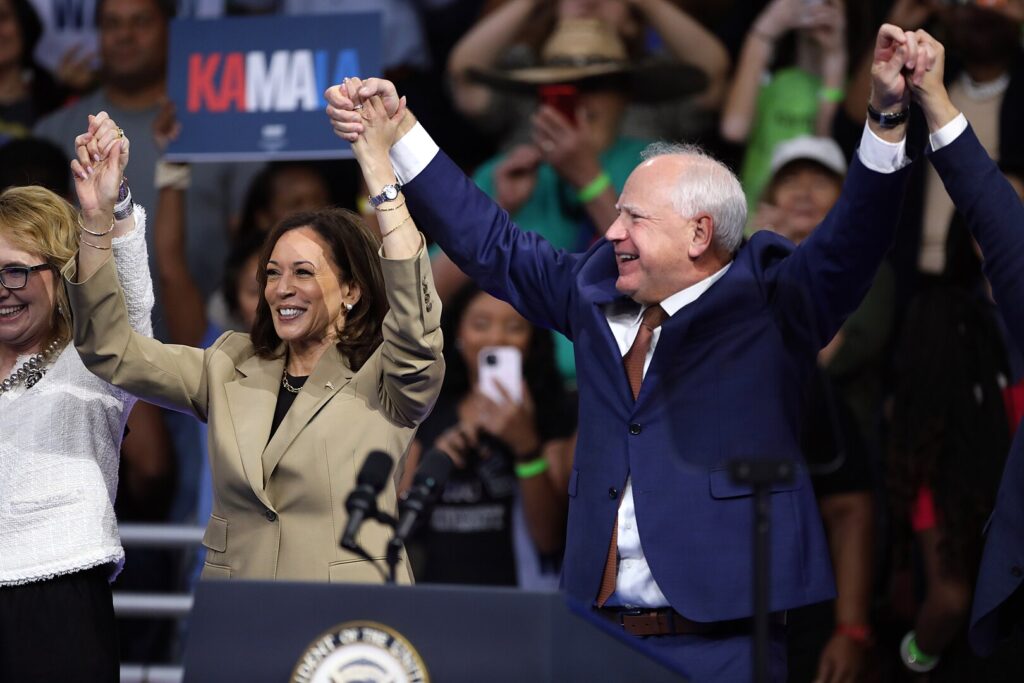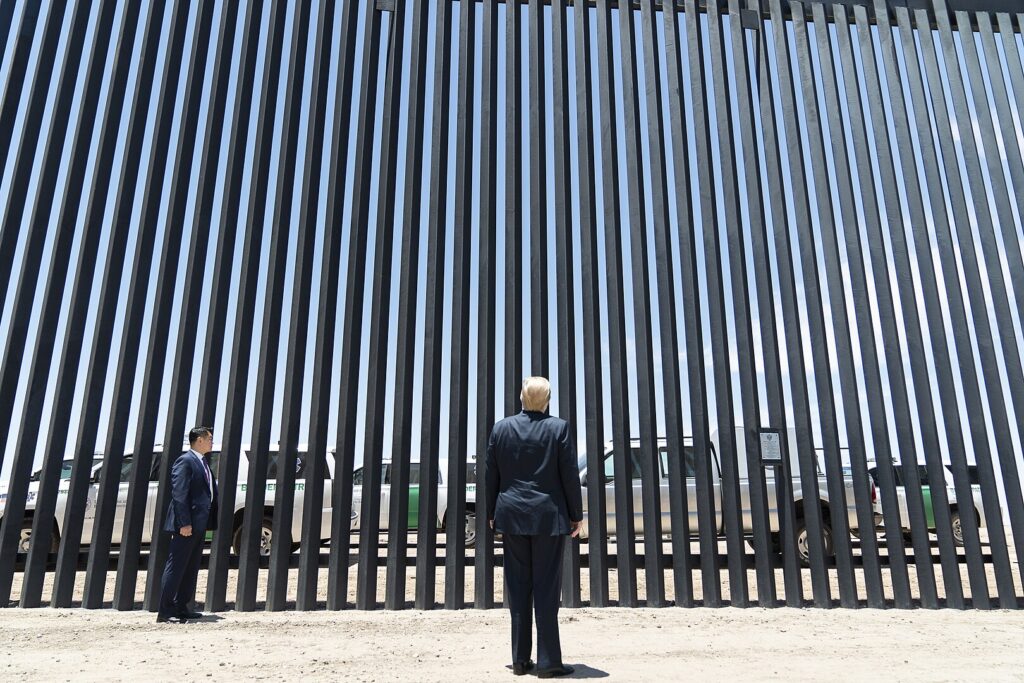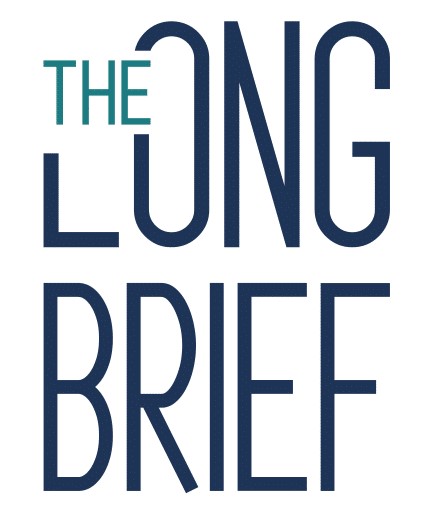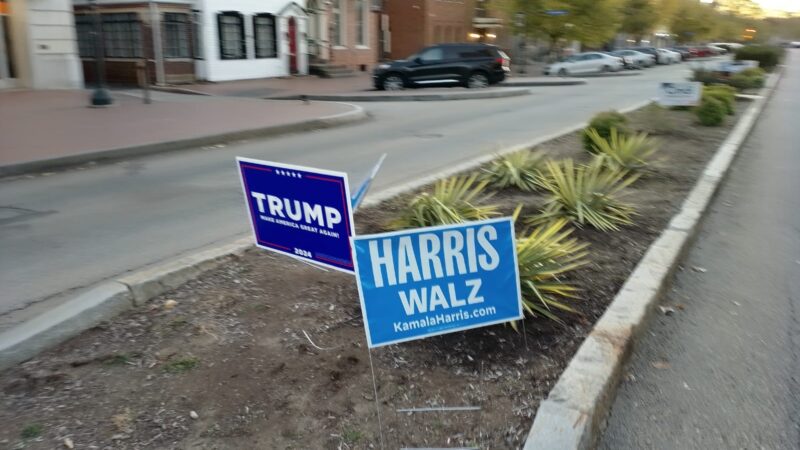Days before the conclusion of one of the closest races in the US Presidential elections ever, people in Pennsylvania, maybe the most fiercely divided states in the United States, have very definite opinions for their preferred nominees. A report on how people living in the biggest city of a true key state are preparing for November 5 by Sergio Velasco from Philadelphia, Pennsylvania.
Before arriving in the United States, I noticed the election atmosphere was very present while waiting at the airport. Most Americans watched newspapers, polls, and videos about the elections. In other words, there was great anxiety about getting informed and seeing what had happened in the previous days.
Upon arriving in the United States, I could already see election posters on the road.
Arriving in Philadelphia, the largest city in Pennsylvania, a key state, most houses show their electoral preference.
In addition to pro-Trump and pro-Harris signs, there are also signs of the Senate candidates. Let’s remember that although elections for Congress and the Senate are every 2 years and are very important, both houses can block measures that the president wishes to implement. Also, by watching TV and being on social media and YouTube, I have noticed that Kamala Harris has the most ads on the internet.

Harris and Tim Walz at a 2024 presidential campaign rally in Arizona (Photo: Gage Skidmore / Wikimedia Commons)
On the street, I asked several people about the electoral environment. The first big question was whether they perceived tension in the environment, a latent hostility in American society, or if this was just an external perception.
Most people commented that, although there are more hostile profiles, most people, whether in family, friendships or at work, do not usually show their political affinity forcefully in everyday conversations. However, most mentioned that, as elections approach, conversations of this type increase, although they have never led to heated discussions.
“We generally talk about who we prefer, but if we don’t agree it stays there and the discussion doesn’t escalate into something more,” a Dominican person interviewed.
Opinions were divided about the possibility of the candidate they did not support winning. Some were not so pessimistic about a change in leadership, noting that, even if they did not like it, the new administration would probably follow the same line as the previous administration, although perhaps with a somewhat more “aggressive” agenda – nothing they were overly concerned about.
“I think (Trump) will continue with the same system, but I think he will have more free rein with the program,” a White American interviewed.
However, another group was genuinely panicked by the idea of a victory for the opposing candidate.
Those who openly supported Kamala Harris feared that, if Donald Trump won on Tuesday, everything would change drastically: they believed that democratic America would disappear and that fascist attitudes could emerge, such as the persecution of journalists, dissidents, and even members of the Republican Party who did not support Trump.
On the other hand, Donald Trump’s supporters feared that with Kamala Harris, the illegal immigration situation would worsen, that the country’s cultural identity would disappear and that the economy would be disastrous, which, they said, could push the United States into a recession.

President Donald J. Trump stands before a plaque Tuesday, June 23, 2020, commemorating the 200th mile of new border wall along the U.S.-Mexico border near Yuma, Ariz. (Official White House Photo by Shealah Craighead)
“Trump is going to kill democracy. He already said it that we wouldn’t have to vote again. It’s hazardous,” said an African-American person.
All the people I was talking to told me they had their vote already thought out and ready for some time.
For most of them, the election campaign began 6 months ago when Trump started to appear everywhere, and there was already talk of electoral revenge. Also, in past elections, not everyone voted for the candidate they would vote for now, although most switched from voting for the Democratic party to the Republican party.
Finally, I asked women which candidate they thought was better and why. All of them told me they would support Kamala Harris, as they felt safer with a woman candidate who could understand their problems. They also showed a deep dislike of Donald Trump, although some of them said their partners would vote for Trump.
“Trump is somebody with 26 sexual assault allegations, wants to infringe on the rights of women autonomy through the abortion ban, and has made comments on harassing women,” said a white woman.
Some people told me that the door-knockers did not aggressively get the person to vote for someone but first asked them if they had registered, which was very important for the country.
Then they would ask them if they already had a candidate in mind, telling them that there was not much difference between the two, that, for example, Trump (if he was pro-Trump) would be better on the economy, but if he were pro-Harris, he would say that she would continue with the path of this government to help the middle class.
From what I have experienced these days in Philadelphia, Delaware, and New Jersey, there is no palpable tension in the atmosphere.
Still, there is a lot of talk about the election. For example, at Walmart, I heard about one of Donald Trump’s key promises: to remove overtime taxes, something working people are very interested in.
The feeling when asked and being with Hispanic people was that most of them will vote firmly for Trump, essentially because of the economic aspect because inflation has caused them an increase in the cost of living.
For example, with energy, gasoline that went from 2$ in the Trump administration to reach almost 6$ in 2022, reaching an average price of 3,50$. Also, as I described above, the majority of women are the ones who are the most determined to vote, with the most secure vote being the majority for Kamala Harris.
The feeling is that everything will be very tight and that the few undecided voters or the latest events may decide the election.
What is clear is that the feeling of a divided country will not be such, at least from what I have heard, that there is not usually an escalation in the discussions about the elections. However, the most radical wing of each “side” will be the first to come out if their candidate loses, but the average citizen will not.
Predictions in Pennsylvania: Narrow Win for Trump
Tables sourced from Wikipedia
| Source | Ranking | As of |
| The Cook Political Report[8] | Tossup | November 2, 2024 |
| Sabato’s Crystal Ball[9] | Tossup | September 25, 2024 |
| Decision Desk HQ/The Hill[10] | Tossup | November 2, 2024 |
| CNN[11] | Tossup | November 2, 2024 |
| The Economist[12] | Tossup | November 2, 2024 |
| 538[13] | Tossup | November 2, 2024 |
| CNalysis[14] | Tilt D | November 2, 2024 |
| Inside Elections[15] | Tossup | November 2, 2024 |
| NBC News[16] | Tossup | November 2, 2024 |
Polling
Kamala Harris vs. Donald Trump
Aggregate polls
| Source of poll aggregation |
Dates administered |
Dates updated |
Kamala Harris Democratic |
Donald Trump Republican |
Other / Undecided [a] |
Margin |
| 270ToWin | October 23 – November 3, 2024 | November 4, 2024 | 48.2% | 48.3% | 3.5% | Trump +0.1% |
| 538 | through November 3, 2024 | November 4, 2024 | 47.7% | 47.9% | 4.4% | Trump +0.2% |
| Silver Bulletin | through November 2, 2024 | November 4, 2024 | 48.0% | 48.4% | 3.6% | Trump +0.4% |
| The Hill/DDHQ | through November 2, 2024 | November 3, 2024 | 48.2% | 48.7% | 3.1% | Trump +0.5% |
| Average | 48.0% | 48.4% | 3.6% | Trump +0.4% | ||







